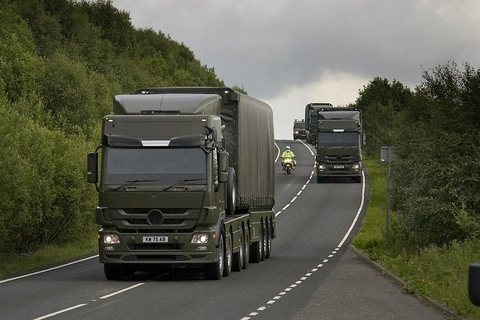The Ministry of Defence has commenced work to meet a government commitment to reduce the overall size of the UK's nuclear warhead stockpile according to the Nukewatch network, which monitors the movements of warhead convoys.
The 2010 Strategic Defence and Security Review gave a commitment to reduce the number of operationally available warheads from fewer than 160 to no more than 120, concluding that “This will enable us to reduce our overall nuclear warhead stockpile ceiling from not more than 225 to not more than 180 by the mid 2020s”.
The annual summary of warhead convoy movements published by Nukewatch for 2011 shows a discrepancy between the numbers of convoys transporting warheads from the Coulport weapons store in Scotland to the Atomic Weapons Establishment (AWE) and the number of return journeys to Coulport. More journeys were seen transporting warheads to AWE than returning to Coulport, suggesting that the programme for reducing the number of UK nuclear warheads which was announced in the Strategic Defence and Security Review has commenced.
Nukewatch estimates that a balance of between two to four warheads was retained at AWE for decommissioning in 2011. This would be consistent with a programme for decommissioning around three warheads per year between 2011 and 2025 to bring the total warhead stockpile down from around 225 warheads to around 180 warheads.
Official statements by the UK government also indicate that warhead decommissioning to reduce the size of the stockpile has commenced. As part of the UK's statement to the 2012 Non Proliferation Treaty Preparatory Committee, Ambassador Jo Adamson told the conference that: “We have already started the implementation of these measures, and have started to reduce our warhead numbers 15 years ahead of schedule”.
Nukewatch warns that sustained monitoring over a period of a further 2-3 years will be needed to confirm whether a gradual annual reduction in warhead numbers is indeed taking place.
Nukewatch reports that, in other respects, the UK's nuclear warhead programme is currently operating a baseline level, with a minimum number of warhead movements taking place over the year consistent with the maintenance and surveillance needs of the programme.
Unusually, convoy movements continued during the period of military action by UK forces in Libya from 19 March to 31 October. Other periods of serious conflict involving UK military forces over recent years, such as the Kosovo intervention and the invasions of Afghanistan and Iraq, have seen a suspension of convoy movements.
As well as reporting on the movement of nuclear weapons, Nukewatch also observed the movement of a Special Nuclear Materials (SNM) convoy transporting enriched uranium from AWE Aldermaston to Rolls-Royce Nuclear at Raynesway, Derby for the manufacture of reactor fuel modules for new Astute class submarines, and a movement of assembled fuel modules from Derby to BAE Systems at Barrow-in-Furness for fitting into a submarine under construction.
The Nukewatch report was compiled on the basis of spottings of nuclear convoys recorded by members of the network during 2011. Annual reports on convoy movements from Nukewatch are one of the few independent benchmarks which can be used to validate government statements on the size and status of the UK nuclear arsenal.
A copy of the Nukewatch annual summary of warhead convoy movements can be downloaded here:
